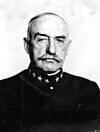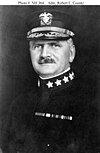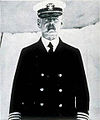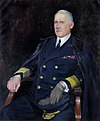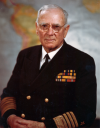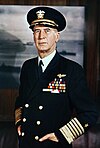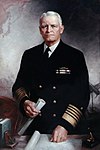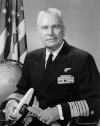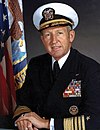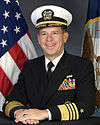Chief of Naval Operations
| Chief of Naval Operations | |
|---|---|
 Flag of the Chief of Naval Operations | |
 Incumbent Admiral John M. Richardson since 18 September 2015 | |
| Department of the Navy | |
| Abbreviation | CNO |
| Member of | Joint Chiefs of Staff |
| Reports to | Secretary of Defense Secretary of the Navy |
| Appointer | The President with Senate advice and consent |
| Term length | 4 years Renewable |
| Constituting instrument | 10 U.S.C. § 5033 |
| Formation | 11 May 1915 |
| First holder | ADM William S. Benson |
| Deputy | Vice Chief of Naval Operations |
| Website | Official website |
The Chief of Naval Operations (CNO) is the highest-ranking officer and professional head of the United States Navy. The position is a statutory office (10 U.S.C. § 5033) held by a four-star admiral who is a military adviser and deputy to the Secretary of the Navy. In a separate capacity as a member of the Joint Chiefs of Staff (10 U.S.C. § 151) the CNO is a military adviser to the National Security Council, the Homeland Security Council, the Secretary of Defense, and the President. The current Chief of Naval Operations is Admiral John M. Richardson.
Despite the title, the CNO does not have operational command authority over Naval forces. The CNO is an administrative position based in the Pentagon, and exercises supervision of Navy organizations as the designee of the Secretary of the Navy. Operational command of naval forces falls within the purview of the Combatant Commanders who report to the Secretary of Defense.
Contents
1 Responsibilities
1.1 Department of the Navy
1.2 Joint Chiefs of Staff
2 Appointment
3 Official Residence
4 Office of the Chief of Naval Operations
5 List of Chiefs of Naval Operations (1915–present)
6 See also
7 References
8 External links
Responsibilities
The Chief of Naval Operations (CNO) is typically the highest-ranking officer on active duty in the U.S. Navy unless the Chairman and/or the Vice Chairman of the Joint Chiefs of Staff are naval officers.[1]
As per 10 U.S.C. § 5035, whenever there is a vacancy for the Chief of Naval Operations or during the absence or disability of the Chief of Naval Operations, and unless the President directs otherwise, the Vice Chief of Naval Operations performs the duties of the Chief of Naval Operations until a successor is appointed or the absence or disability ceases.[2]
The CNO also performs all other functions prescribed under 10 U.S.C. § 5033, such as presiding over the Office of the Chief of Naval Operations (OPNAV), exercising supervision of Navy organizations, and other duties assigned by the Secretary or higher lawful authority, or the CNO delegates those duties and responsibilities to other officers in OPNAV or in organizations below.[1][3]
Acting for the Secretary of the Navy, the CNO also designates naval personnel and naval forces available to the commanders of Unified Combatant Commands, subject to the approval of the Secretary of Defense.[3][4]
Joint Chiefs of Staff
The CNO is a member of the Joint Chiefs of Staff as prescribed by 10 U.S.C. § 151 and 10 U.S.C. § 5033. Like the other members of the Joint Chiefs of Staff, the CNO is an administrative position, with no operational command authority over the United States Navy forces.
Members of the Joint Chiefs of Staff, individually or collectively, in their capacity as military advisers, shall provide advice to the President, the National Security Council (NSC), or the Secretary of Defense (SECDEF) on a particular matter when the President, the NSC, or SECDEF requests such advice. Members of the Joint Chiefs of Staff (other than the Chairman of the Joint Chiefs of Staff) may submit to the Chairman advice or an opinion in disagreement with, or advice or an opinion in addition to, the advice presented by the Chairman to the President, NSC, or SECDEF.
When performing his JCS duties, the CNO is responsible directly to the SECDEF, but keeps SECNAV fully informed of significant military operations affecting the duties and responsibilities of the SECNAV, unless SECDEF orders otherwise.[5]
Appointment
The Chief of Naval Operations is nominated by the President for appointment and must be confirmed by the Senate.[6] A requirement for being Chief of Naval Operations is having significant experience in joint duty assignments, which includes at least one full tour of duty in a joint duty assignment as a flag officer.[6] However, the president may waive those requirements if he determines that appointing the officer is necessary for the national interest.[6] By statute, the CNO is appointed as a four-star admiral.[6]
Official Residence
Number One Observatory Circle, located on the northeast grounds of the United States Naval Observatory in Washington, DC, was built in 1893 for its superintendent. The Chief of Naval Operations liked the house so much that in 1923 he took over the house as his own official residence. It remained the residence of the CNO until 1974, when Congress authorized its transformation to an official residence for the Vice President.[7] The Chief of Naval Operations currently resides in Quarters A in the Washington Naval Yard.

Organizational chart of the Office of the Chief of Naval Operations (OPNAV).
The Chief of Naval Operations presides over the Navy Staff, formally known as the Office of the Chief of Naval Operations (OPNAV).[8][9]
The Office of the Chief of Naval Operations is a statutory organization within the executive part of the Department of the Navy, and its purpose is to furnish professional assistance to the Secretary of the Navy (SECNAV) and the CNO in carrying out their responsibilities.[10][11]
The OPNAV organization consists of:
- The Chief of Naval Operations (CNO)
- The Vice Chief of Naval Operations (VCNO), the principal deputy of the Chief of Naval Operations, delegated complete authority to act for the CNO in all matters not specifically reserved by law to the CNO.
- The Director of the Navy Staff (DNS).
- Several Deputy Chiefs of Naval Operations (DCNOs)[12] of either three or two-star rank, heading functional directorates.
- (N1) DCNO Manpower, Personnel, Training, & Education/Chief of Naval Personnel
- (N2/N6) DCNO Warfare Dominance/Director of the Office of Naval Intelligence
- (N3/N5) DCNO Operations, Plans, & Strategy
- (N4) DCNO Fleet Readiness & Logistics
- (N8) DCNO Integration of Capabilities & Resources
- (N9) DCNO Warfare Systems
- (N1) DCNO Manpower, Personnel, Training, & Education/Chief of Naval Personnel
- (N00D) The Master Chief Petty Officer of the Navy (MCPON), appointed by the Chief of Naval Operations to serve as a spokesperson to address the issues of enlisted personnel to the highest positions in the Navy.
- (N00N) The Director of the Naval Nuclear Propulsion Program, a unique eight-year posting held by a 4 star admiral, which was originally created and served in by Admiral Hyman G. Rickover. The appointment as Director is both a military and civilian position as it is the head of the Naval Nuclear Propulsion Program in the Department of the Navy and deputy administrator for the Office of Naval Reactors of the National Nuclear Security Administration in the Department of Energy.[13][14][15]
- (N093) The Surgeon General of the Navy, the most senior officer in the Medical Corps who heads the Bureau of Medicine and Surgery (BUMED).
- (N095) The Chief of Navy Reserve/Commander, Navy Reserve Force.
- (N097) The Chief of Chaplains.
- In addition, there are officials who are by either law or regulation part of the Office of the Secretary of the Navy (also known as the Secretariat), but who advise the CNO and OPNAV, on an additional duty basis, within their area of specialty, these include:
- (N09C) Special Assistant for Public Affairs Support, additional duty for the Chief of Information (CHINFO).
- (N09G) Special Assistant for Inspection Support, additional duty for the Naval Inspector General (NIG).
- (N09J) Special Assistant for Legal Services, additional duty for the Judge Advocate General of the Navy (JAG).
- (N09L) Special Assistant for Legislative Support, additional duty for the Chief of Legislative Affairs (CLA).
- (N09N) Special Assistant for Naval Investigative Matters and Security, additional duty for the Director of the Naval Criminal Investigative Service.
Policy documents emanating from the CNO are issued in the form of OPNAV Instructions.
OPNAV is one of the three headquarters staffs in Department of the Navy mainly based at The Pentagon, with the others being the Office of the Secretary of the Navy and Headquarters, Marine Corps.
The position of CNO replaced the position of Aide for Naval Operations, which was a position established by regulation rather than statutory law.[16] († - died in office)

Mullen (CNO in December 2006) with some of his predecessors: Clark, Watkins, Hayward and Johnson
| № | Chief of Naval Operations | Took office | Left office | Time in office | |
|---|---|---|---|---|---|
| 1 | Benson, WilliamAdmiral William S. Benson (1855–1932) | 11 May 1915 | 25 September 1919 | 7003159800000000000♠4 years, 137 days | |
| 2 | Coontz, RobertAdmiral Robert E. Coontz (1864–1935) | 1 November 1919 | 21 July 1923 | 7003135800000000000♠3 years, 262 days | |
| 3 | Eberle, EdwardAdmiral Edward W. Eberle (1864–1929) | 21 July 1923 | 14 November 1927 | 7003157700000000000♠4 years, 116 days | |
| 4 | Hughes, CharlesAdmiral Charles F. Hughes (1866–1934) | 14 November 1927 | 17 September 1930 | 7003109900000000000♠3 years, 3 days | |
| 5 | Pratt, WilliamAdmiral William V. Pratt (1869–1957) | 17 September 1930 | 30 June 1933 | 7003101700000000000♠2 years, 286 days | |
| 6 | Standley, WilliamAdmiral William H. Standley (1872–1963) | 1 July 1933 | 1 January 1937 | 7003128000000000000♠3 years, 184 days | |
| 7 | Leahy, WilliamFleet Admiral William D. Leahy (1875–1959) | 2 January 1937 | 1 August 1939 | 7002941000000000000♠2 years, 211 days | |
| 8 | Stark, HaroldAdmiral Harold R. Stark (1880–1972) | 1 August 1939 | 2 March 1942 | 7002944000000000000♠2 years, 213 days | |
| 9 | King, ErnestFleet Admiral Ernest J. King (1878–1956) | 2 March 1942 | 15 December 1945 | 7003138400000000000♠3 years, 288 days | |
| 10 | Nimitz, ChesterFleet Admiral Chester W. Nimitz (1885–1966) | 15 December 1945 | 15 December 1947 | 7002730000000000000♠2 years, 0 days | |
| 11 | Denfeld, LouisAdmiral Louis E. Denfeld (1891–1972) | 15 December 1947 | 2 November 1949 | 7002688000000000000♠1 year, 322 days | |
| 12 | Sherman, ForrestAdmiral Forrest P. Sherman (1896–1951) | 2 November 1949 | 22 July 1951 † | 7002627000000000000♠1 year, 262 days | |
| 13 | Fechteler, WilliamAdmiral William M. Fechteler (1896–1967) | 16 August 1951 | 17 August 1953 | 7002732000000000000♠2 years, 1 day | |
| 14 | Carney, RobertAdmiral Robert B. Carney (1895–1990) | 17 August 1953 | 17 August 1955 | 7002730000000000000♠2 years, 0 days | |
| 15 | Burke, ArleighAdmiral Arleigh A. Burke (1901–1996) | 17 August 1955 | 1 August 1961 | 7003217600000000000♠5 years, 349 days | |
| 16 | Anderson, GeorgeAdmiral George W. Anderson Jr. (1906–1992) | 1 August 1961 | 1 August 1963 | 7002730000000000000♠2 years, 0 days | |
| 17 | McDonald, DavidAdmiral David L. McDonald (1906–1997) | 1 August 1963 | 1 August 1967 | 7003146100000000000♠4 years, 0 days | |
| 18 | Moorer, ThomasAdmiral Thomas H. Moorer (1912–2004) | 1 August 1967 | 1 July 1970 | 7003106500000000000♠2 years, 334 days | |
| 19 | Zumwalt, ElmoAdmiral Elmo R. Zumwalt (1920–2000) | 1 July 1970 | 29 June 1974 | 7003145900000000000♠3 years, 363 days | |
| 20 | Holloway, JamesAdmiral James L. Holloway III (born 1922) | 29 June 1974 | 1 July 1978 | 7003146300000000000♠4 years, 2 days | |
| 21 | Hayward, ThomasAdmiral Thomas B. Hayward (born 1924) | 1 July 1978 | 30 June 1982 | 7003146000000000000♠3 years, 364 days | |
| 22 | Watkins, JamesAdmiral James D. Watkins (1927–2012) | 30 June 1982 | 30 June 1986 | 7003146100000000000♠4 years, 0 days | |
| 23 | Trost, CarlisleAdmiral Carlisle A.H. Trost (born 1930) | 1 July 1986 | 29 June 1990 | 7003145900000000000♠3 years, 363 days | |
| 24 | Kelso, FrankAdmiral Frank B. Kelso II (1933–2013) | 29 June 1990 | 23 April 1994 | 7003139400000000000♠3 years, 298 days | |
| 25 | Boorda, JeremyAdmiral Jeremy M. Boorda (1939–1996) | 23 April 1994 | 16 May 1996 † | 7002754000000000000♠2 years, 23 days | |
| 26 | Johnson, JayAdmiral Jay L. Johnson (born 1946) | 16 May 1996 | 21 July 2000 | 7003152700000000000♠4 years, 66 days | |
| 27 | Clark, VernAdmiral Vern Clark (born 1944) | 21 July 2000 | 22 July 2005 | 7003182700000000000♠5 years, 1 day | |
| 28 | Mullen, MichaelAdmiral Michael Mullen (born 1946) | 22 July 2005 | 29 September 2007 | 7002860000000000000♠2 years, 130 days | |
| 29 | Roughead, GaryAdmiral Gary Roughead (born 1951) | 29 September 2007 | 23 September 2011 | 7003139400000000000♠3 years, 298 days | |
| 30 | Greenert, JonathanAdmiral Jonathan W. Greenert (born 1953) | 23 September 2011 | 18 September 2015 | 7003145600000000000♠3 years, 360 days | |
| 31 | Richardson, JohnAdmiral John M. Richardson (born 1960) | 18 September 2015 | Incumbent | 7003127700000000000♠3 years, 181 days |
See also
- Vice Chief of Naval Operations
- Master Chief Petty Officer of the Navy
- Organization of the US Marine Corps – Relationship with other uniformed services
- United States Fleet
References
^ ab "Chief of Naval Operations". United States Navy. Retrieved 31 January 2018..mw-parser-output cite.citation{font-style:inherit}.mw-parser-output .citation q{quotes:"""""""'""'"}.mw-parser-output .citation .cs1-lock-free a{background:url("//upload.wikimedia.org/wikipedia/commons/thumb/6/65/Lock-green.svg/9px-Lock-green.svg.png")no-repeat;background-position:right .1em center}.mw-parser-output .citation .cs1-lock-limited a,.mw-parser-output .citation .cs1-lock-registration a{background:url("//upload.wikimedia.org/wikipedia/commons/thumb/d/d6/Lock-gray-alt-2.svg/9px-Lock-gray-alt-2.svg.png")no-repeat;background-position:right .1em center}.mw-parser-output .citation .cs1-lock-subscription a{background:url("//upload.wikimedia.org/wikipedia/commons/thumb/a/aa/Lock-red-alt-2.svg/9px-Lock-red-alt-2.svg.png")no-repeat;background-position:right .1em center}.mw-parser-output .cs1-subscription,.mw-parser-output .cs1-registration{color:#555}.mw-parser-output .cs1-subscription span,.mw-parser-output .cs1-registration span{border-bottom:1px dotted;cursor:help}.mw-parser-output .cs1-ws-icon a{background:url("//upload.wikimedia.org/wikipedia/commons/thumb/4/4c/Wikisource-logo.svg/12px-Wikisource-logo.svg.png")no-repeat;background-position:right .1em center}.mw-parser-output code.cs1-code{color:inherit;background:inherit;border:inherit;padding:inherit}.mw-parser-output .cs1-hidden-error{display:none;font-size:100%}.mw-parser-output .cs1-visible-error{font-size:100%}.mw-parser-output .cs1-maint{display:none;color:#33aa33;margin-left:0.3em}.mw-parser-output .cs1-subscription,.mw-parser-output .cs1-registration,.mw-parser-output .cs1-format{font-size:95%}.mw-parser-output .cs1-kern-left,.mw-parser-output .cs1-kern-wl-left{padding-left:0.2em}.mw-parser-output .cs1-kern-right,.mw-parser-output .cs1-kern-wl-right{padding-right:0.2em}
^ "10 USC 5035. Vice Chief of Naval Operations". Legal Information Institute. Cornell University Law School. Retrieved August 25, 2018.
^ 10 USC 165. Combatant commands: administration and support
^ "10 USC 5033. Chief of Naval Operations". Legal Information Institute. Cornell University Law School. Retrieved August 25, 2018.
^ abcd "10 USC 5033. Chief of Naval Operations". Retrieved 24 September 2007.
^ "The Vice President's Residence". The White House. Archived from the original on 21 October 2009. Retrieved 31 January 2018.
^ navy.mil Archived 22 July 2011 at the Wayback Machine Chief of Naval Operations − Responsibilities. Retrieved 3 July 2010.
^ "10 U.S. Code § 5033 - Chief of Naval Operations: general duties". Legal Information Institute. Cornell University Law School. Retrieved August 25, 2018.
^ "10 U.S. Code § 5031 - Office of the Chief of Naval Operations: function; composition". Legal Information Institute. Cornell University Law School. Retrieved August 25, 2018.
^ "10 U.S. Code § 5032 - Office of the Chief of Naval Operations: general duties". Legal Information Institute. Cornell University Law School. Retrieved August 25, 2018.
^ 10 U.S. Code § 5036 - Deputy Chiefs of Naval Operations
^ "NNSA Leadership". www.energy.gov. United States Department of Energy. Retrieved February 18, 2019.
^ "Powering the Navy". www.energy.gov. United States Department of Energy. Retrieved February 18, 2019.
^ "National Nuclear Security Administration". National Nuclear Security Administration, Department of Energy 2009. Department of Energy www.Energy.gov. Archived from the original on June 5, 2009. Retrieved 14 August 2009.
^ "Navy - Chief of Naval Operations". International Military Digest. 1 (1): 68. June 1915. Retrieved 21 May 2015.
External links
| Wikimedia Commons has media related to Chiefs of Naval Operations. |
- Chief of Naval Operations page
- Office of the Chief of Naval Operations organization
"Chief of Naval Operations". Lists of Commanding Officers and Senior Officials of the US Navy. Naval Historical Center. Archived from the original on 18 December 2007. Retrieved 6 November 2007.
